Scan-to-BIM Process and Architectural Conservation: Towards an Effective Tool for the Thematic Mapping of Decay and Alteration Phenomena
Abstract
1. Introduction
1.1. The Current State of the Art of Decay Mapping in HBIM
1.2. Research Motivation and Research Aims
2. The Case Study of the Church of “Santa Maria della Grotta” in Marsala (Italy)
3. Methodology and Tools
3.1. The 3D Survey
3.2. Processing of the Acquired Data
3.3. The Parametric Modelling
3.4. Decay and Alteration Phenomena Identification and Mapping in HBIM
4. Discussion and Results
5. Conclusions
Author Contributions
Funding
Data Availability Statement
Acknowledgments
Conflicts of Interest
References
- Pocobelli, D.P.; Boehm, J.; Bryan, P.; Still, J.; Grau-Bovè, J. BIM for heritage science: A review. Herit. Sci. 2018, 6, 30. [Google Scholar] [CrossRef]
- Lovell, L.J.; Davies, R.J.; Hunt, D.V.L. The application of Historic Building Information Modelling (HBIM) to Cultural Heritage: A review. Heritage 2023, 6, 6691–6717. [Google Scholar] [CrossRef]
- Murphy, M.; McGovern, E.; Pavia, S. Historic building information modelling (HBIM). Struct. Surv. 2009, 27, 311–327. [Google Scholar] [CrossRef]
- Volk, R.; Stengel, J.; Schultmann, J. Building Information Modelling (BIM) for existing buildings. Literature review and future needs. Autom. Constr. 2014, 38, 109–127. [Google Scholar] [CrossRef]
- Charlton, J.; Kelly, K.; Greenwood, D.; Moreton, L. The Complexities of Managing Historic Buildings with BIM. Eng. Constr. Archit. Manag. 2021, 28, 570–583. [Google Scholar] [CrossRef]
- Antonopoulou, S.; Bryan, P. BIM for Heritage: Developing a Historic Building Information Model; Historic England: Swindon, UK, 2017.
- Quattrini, R.; Pierdicca, R.; Morbidoni, C.; Malinverni, E.S. Conservation-oriented HBIM. The BIM explorer tool. Int. Arch. Photogramm. Remote Sens. Spatial Inf. Sci. 2017, 42, 275–281. [Google Scholar] [CrossRef]
- Brumana, R.; Georgopoulos, A.; Oreni, D.; Raimondi, A.; Bregianni, A. HBIM for Documentation, Dissemination and Management of Built Heritage. The Case Study of St. Maria in Scaria d’Intelvi. Int. J. Herit. Digit. Era 2013, 2, 433–451. [Google Scholar] [CrossRef]
- Brusaporci, S.; Ruggeri, G.; Maiezza, P.; Tata, A.; Trizio, I.; Giannangeli, A. AHBIM per l’analisi stratigrafica dell’architettura storica. Restauro Archeol. 2018, 26, 112–131. [Google Scholar] [CrossRef]
- Fazion, B.; Treccani, D.; Fregonese, L.; Lombardini, N. HBIM structural model to evaluate building evolution and construction hypotheses: Preliminary results. Int. Arch. Photogramm. Remote Sens. Spat. Inf. Sci. 2024, 48, 213–219. [Google Scholar] [CrossRef]
- López, F.J.; Lerones, P.M.; Llamas, J.; Gómez-García-Bermejo, J.; Zalama, E. A Review of Heritage Building Information Modeling (H-BIM). Multimodal Technol. Interact. 2018, 2, 21. [Google Scholar] [CrossRef]
- Conti, A.; Fiorini, L.; Massaro, R.; Santoni, C.; Tucci, G. HBIM for the preservation of a historic infrastructures: The Carlo III bridge of the Carolino Aqueduct. Appl. Geomat. 2020, 14, 41–51. [Google Scholar] [CrossRef]
- Biancardo, S.A.; Intignano, M.; Veropalumbo, R.; Martinelli, R.; Calvanese, V.; Autelitano, F.; Garilli, E.; Giuliani, F.; Dell’Acqua, G. BIM approach for stone pavements in Archaeological Sites: The case study of Vicolo dei Balconi of Pompeii. Transp. Res. Interdiscip. Perspect. 2023, 17, 100755. [Google Scholar] [CrossRef]
- Brumana, R.; Oreni, D.; Barazzetti, L.; Cuca, B.; Previtali, M.; Banfi, F. Survey and Scan to BIM Model for the Knowledge of Built Heritage and the Management of Conservation Activities. In Digital Transformation of the Design, Construction and Management Processes of the Built Environment; Daniotti, B., Gianinetto, M., Della Torre, S., Eds.; Springer: Cham, Switzerland, 2020; pp. 391–400. [Google Scholar] [CrossRef]
- Rocha, G.; Mateus, L.; Fernández, J.; Ferreira, V. A Scan-to-BIM Methodology Applied to Heritage Buildings. Heritage 2020, 3, 47–67. [Google Scholar] [CrossRef]
- Mateus, L.; Fernández, J.; Ferreira, V.; Oliveira, C.; Aguiar, J.; Gago, A.S.; Pacheco, P.; Pernão, J. Terrestrial laser scanning and digital photogrammetry for heritage conservation: Case study of the historical walls of Lagos, Portugal. Int. Arch. Photogramm. Remote Sens. Spat. Inf. Sci. 2019, 42, 843–847. [Google Scholar] [CrossRef]
- Pepe, M.; Costantino, D. UAV Photogrammetry and 3D Modelling of Complex Architecture for Maintenance Purposes: The Case Study of the Masonry Bridge on the Sele River, Italy. Period. Polytech. Civ. Eng. 2021, 65, 191–203. [Google Scholar] [CrossRef]
- Aricò, M.; Lo Brutto, M. From Scan-to-BIM to Heritage Building Information Modelling for ancient Arab-Norman church. Int. Arch. Photogramm. Remote Sens. Spat. Inf. Sci. 2022, 43, 761–768. [Google Scholar] [CrossRef]
- Vieira, M.M.; Ribeiro, G.; Paulo, R.; Bessa, M.; Sousa, F.R.; Moreira, E.; Mesquita, E. Strategy for HBIM implementation using high-resolution 3D architectural documentation based on laser scanning and photogrammetry of the José de Alencar theatre. Digit. Appl. Archaeol. Cult. Herit. 2023, 30, e00287. [Google Scholar] [CrossRef]
- Dostal, C.; Yamafune, K. Photogrammetric texture mapping: A method for increasing the fidelity of 3D models of cultural heritage materials. J. Archaeol. Sci. Rep. 2018, 18, 430–436. [Google Scholar] [CrossRef]
- Alshawabkeh, Y.; Baik, A. Integration of photogrammetry and laser scanning for enhancing scan-to-HBIM modeling of Al Ula heritage site. Herit. Sci. 2023, 11, 147. [Google Scholar] [CrossRef]
- Malinverni, E.S.; Pierdicca, R.; Sturari, M.; Colosi, F.; Orazi, R. Documentation and detection of colour changes of bas relieves using close-range photogrammetry. Int. Arch. Photogramm. Remote Sens. Spat. Inf. Sci. 2017, 42, 203–210. [Google Scholar] [CrossRef]
- Rinaudo, F.; Scolamiero, V. Comparison of multi-source data, integrated survey for complex architecture documentation. Int. Arch. Photogramm. Remote Sens. Spat. Inf. Sci. 2021, 46, 625–631. [Google Scholar] [CrossRef]
- Santagati, C.; Papacharalambous, D.; Sanfilippo, G.; Bakirtzis, N.; Laurini, C.; Hermon, S. HBIM approach for the knowledge and documentation of the St. John the Theologian cathedral in Nicosia (Cyprus). J. Archaeol. Sci. Rep. 2021, 36, 102804. [Google Scholar] [CrossRef]
- Chiabrando, F.; Lo Turco, M.; Rinaudo, F. Modelling the decay in a HBIM starting from 3D point clouds. A followed approach for Cultural Heritage knowledge. Int. Arch. Photogramm. Remote Sens. Spat. Inf. Sci. 2017, 42, 605–612. [Google Scholar] [CrossRef]
- Mol, A.; Cabaleiro, M.; Sousa, H.S.; Branco, J.M. HBIM for storing life-cycle data regarding decay and damage in existing timber structures. Autom. Constr. 2020, 117, 103262. [Google Scholar] [CrossRef]
- Croce, V.; Caroti, G.; Piemonte, A.; Bevilacqua, M.G. Geomatics for Cultural Heritage conservation: Integrated survey and 3D modelling. In Proceedings of the International Conference on Metrology for Archaeology and Cultural Heritage, MetroArchaeo, (IMEKO TC-4), Florence, Italy, 4 December 2019; pp. 217–276. [Google Scholar]
- Ferro, A.; Lo Brutto, M.; Ventimiglia, G.M. A Scan-to-BIM process for the monitoring and conservation of the Cultural Heritage: Integration of thematic information in a HBIM model. Int. Arch. Photogramm. Remote Sens. Spat. Inf. Sci. 2023, 48, 549–556. [Google Scholar] [CrossRef]
- Saricaoglu, T.; Saygi, G. Data-driven conservation actions of heritage places curated with HBIM. Virtual Archaeol. Rev. 2022, 13, 17–32. [Google Scholar] [CrossRef]
- Malinverni, E.S.; Mariano, F.; Di Stefano, F.; Petetta, L.; Onori, F. Modelling in HBIM to document materials decay by a thematic mapping to manage the Cultural Heritage: The case of “Chiesa della Pietà” in Fermo. Int. Arch. Photogramm. Remote Sens. Spat. Inf. Sci. 2019, 42, 777–784. [Google Scholar] [CrossRef]
- Del Pozzo, D.; Treccani, D.; Appolonia, L.; Adami, A.; Scala, B. HBIM and thematic mapping: Preliminary results. Int. Arch. Photogramm. Remote Sens. Spat. Inf. Sci. 2022, 46, 199–206. [Google Scholar] [CrossRef]
- Banfi, F.; Brumana, R.; Landi, A.G.; Previtali, M.; Roncoroni, F.; Stanga, C. Building archaeology informative modelling turned into 3D volume stratigraphy and extended reality time-lapse communication. Virtual Archaeol. Rev. 2022, 13, 1–21. [Google Scholar] [CrossRef]
- Guida, C.G.; Limongiello, M.; Lorusso, A.; Sanseverino, A. From 2D to BIM: Decay mapping projection via Visual Programming Script. Esempi Di Archit. 2021, 149–157. [Google Scholar]
- Lanzara, E.; Scandurra, S.; Musella, C.; Palomba, D.; di Luggo, A.; Asprone, D. Documentation of structural damage and material decay phenomena in H-BIM systems. Int. Arch. Photogramm. Remote Sens. Spat. Inf. Sci. 2021, 46, 375–382. [Google Scholar] [CrossRef]
- Croce, V.; Caroti, G.; Piemonte, A. Propagation of semantic information between orthophoto and 3D replica: A H-BIM system for the north transept of Pisa Cathedral. Geomat. Nat. Hazards Risk 2021, 12, 2225–2252. [Google Scholar] [CrossRef]
- Caruso, E. L’abbazia basiliana di Santa Maria della Grotta. In Federico e la Sicilia; Ediprint: Siracusa, Italy, 1995; pp. 239–245. [Google Scholar]
- Aricò, M.; Dardanelli, G.; La Guardia, M.; Lo Brutto, M. Three-Dimensional Documentation and Virtual Web Navigation System for the Indoor and Outdoor Exploration of a Complex Cultural Heritage Site. Electronics 2024, 13, 2833. [Google Scholar] [CrossRef]
- Radanovic, M.; Khoshelham, K.; Fraser, C. Geometric accuracy and semantic richness in heritage BIM: A review. Digit. Appl. Archaeol. Cult. Herit. 2020, 19, e00166. [Google Scholar] [CrossRef]
- Hamed, W.; El Antably, A. Knowledge-based HBIM for conservation: The case of Yahya al-Shabih mausoleum. Digit. Appl. Archaeol. Cult. Herit. 2023, 30, e00278. [Google Scholar] [CrossRef]
- Allegra, V.; Di Paola, F.; Lo Brutto, M.; Vinci, C. Scan-to-BIM for the management of Heritage Building: The case study of the Castle of Maredolce (Palermo, Italy). Int. Arch. Photogramm. Remote Sens. Spat. Inf. Sci. 2020, 43, 1355–1362. [Google Scholar] [CrossRef]
- Aricò, M.; Lo Brutto, M.; Maltese, A. A Scan-to-BIM approach for the management of two Arab-Norman churches in Palermo (Italy). Heritage 2023, 6, 1622–1644. [Google Scholar] [CrossRef]
- Scianna, A.; Gaglio, G.F.; La Guardia, M. HBIM data management in historical and archaeological buildings. Archeol. E Calc. 2020, 31, 231–252. [Google Scholar] [CrossRef]
- Donato, A.; Randazzo, L.; Ricca, M.; Rovella, N.; Collina, M.; Ruggieri, N.; Dodaro, F.; Costanzo, A.; Alberghina, M.F.; Schiavone, S. Decay Assessment of Stone-Built Cultural Heritage: The Case Study of the Cosenza Cathedral Façade (South Calabria, Italy). Remote Sens. 2021, 13, 3925. [Google Scholar] [CrossRef]
- Diz-Mellado, E.; Mascort-Albea, E.J.; Romero-Hernández, R.; Galán-Marín, C.; Rivera-Gómez, C.; Ruiz-Jaramillo, J.; Jaramillo-Morilla, A. Non-destructive testing and Finite Element Method integrated procedure for heritage diagnosis: The Seville Cathedral case study. J. Build. Eng. 2021, 37, 102134. [Google Scholar] [CrossRef]
- ICOMOS International Scientific Committee for Stone (ISCS). Illustrated Glossary on Stone Deterioration Patterns; Ateliers 30 Impression: Champigny sur Marne, France, 2008. [Google Scholar]
- Cameron, C. UNESCO and Cultural Heritage. In A Companion to Heritage Studies; Logan, W., Craith, M.N., Kockel, U., Eds.; John Wiley & Sons: Hoboken, NJ, USA, 2015. [Google Scholar]
- Moropoulou, A.; Labropoulos, K.C.; Delegou, E.T.; Karoglou, M.; Bakolas, A. Non-destructive techniques as a tool for the protection of built cultural heritage. Constr. Build. Mater. 2013, 48, 1222–1239. [Google Scholar] [CrossRef]
- Kadi, H.; Anouche, K. Knowledge-based parametric modeling for heritage interpretation and 3D reconstruction. Digit. Appl. Archaeol. Cult. Herit. 2020, 19, e00160. [Google Scholar] [CrossRef]
- Centarti, L.; Ferreyra, C.; Guida, C.G.; Limongiello, M.; Messina, B. Documentation and management of complex 3D morphologies through digital technology. Acta IMEKO 2024, 13, 1–7. [Google Scholar] [CrossRef]
- Penjor, T.; Banihashemi, S.; Hajirasouli, A.; Golzad, H. Heritage Building Information Modelling (HBIM) for Heritage Conservation: Framework of Challenges, Gaps, and Existing limitations of HBIM. Digit. Appl. Archaeol. Cult. Herit. 2024, 35, e00366. [Google Scholar] [CrossRef]

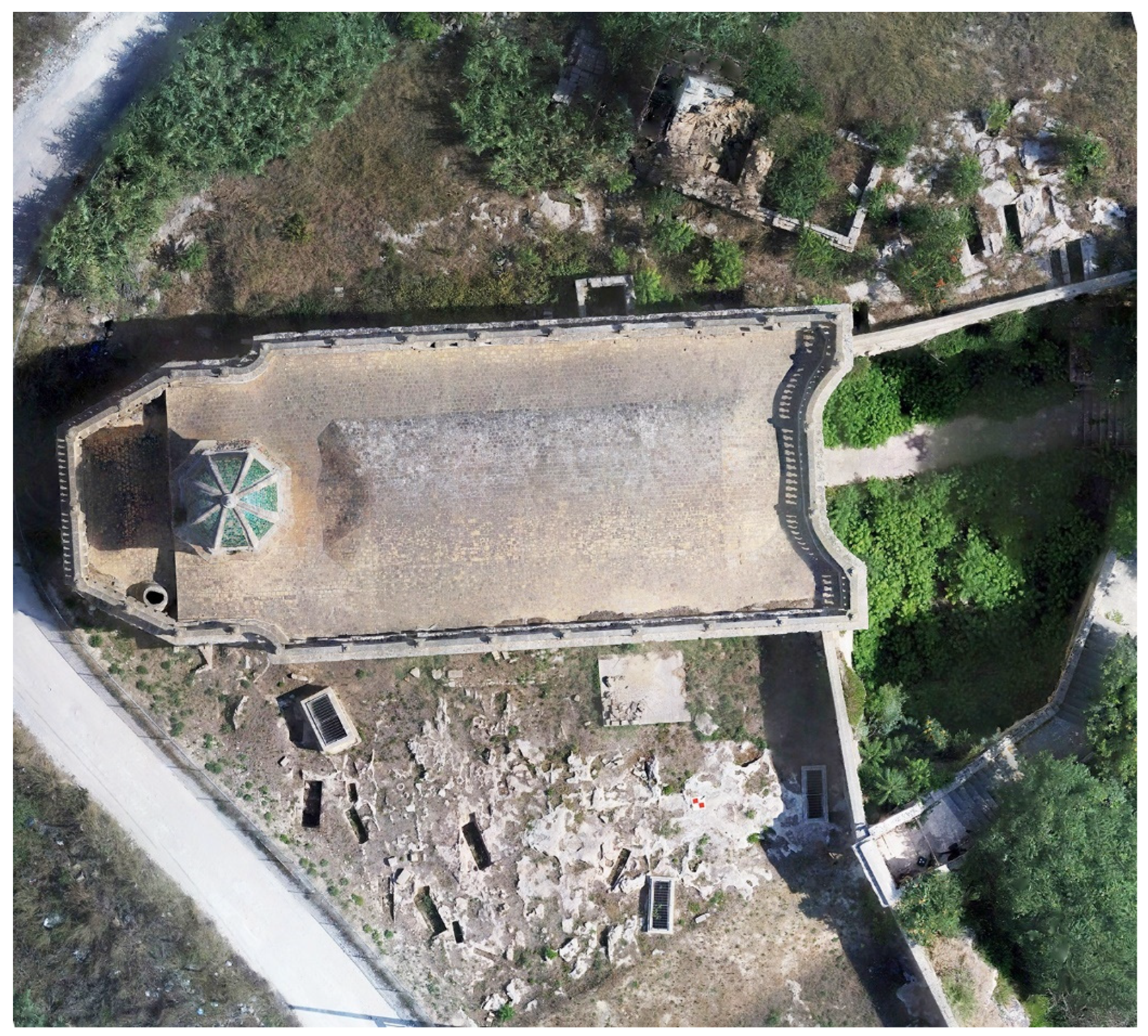
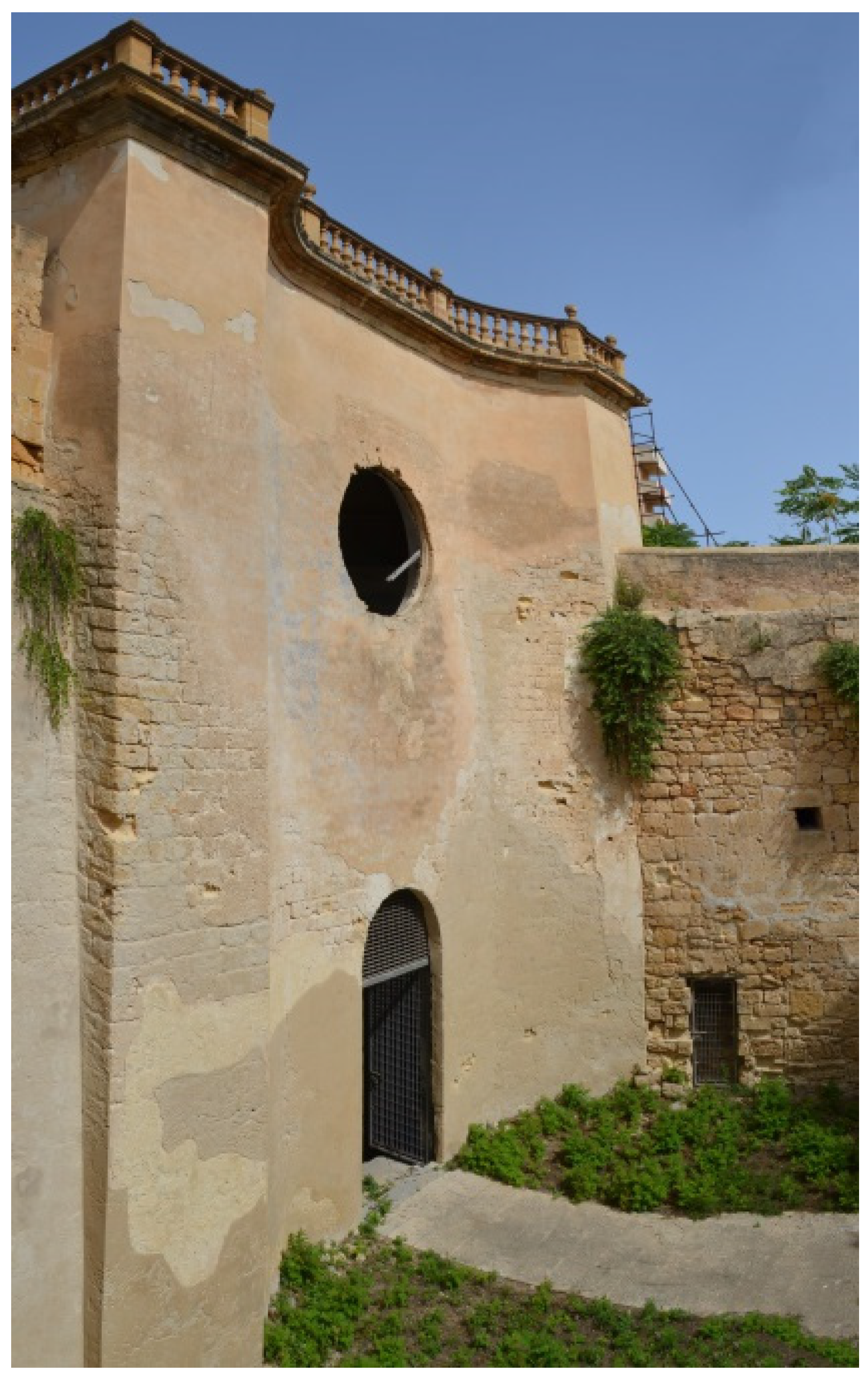
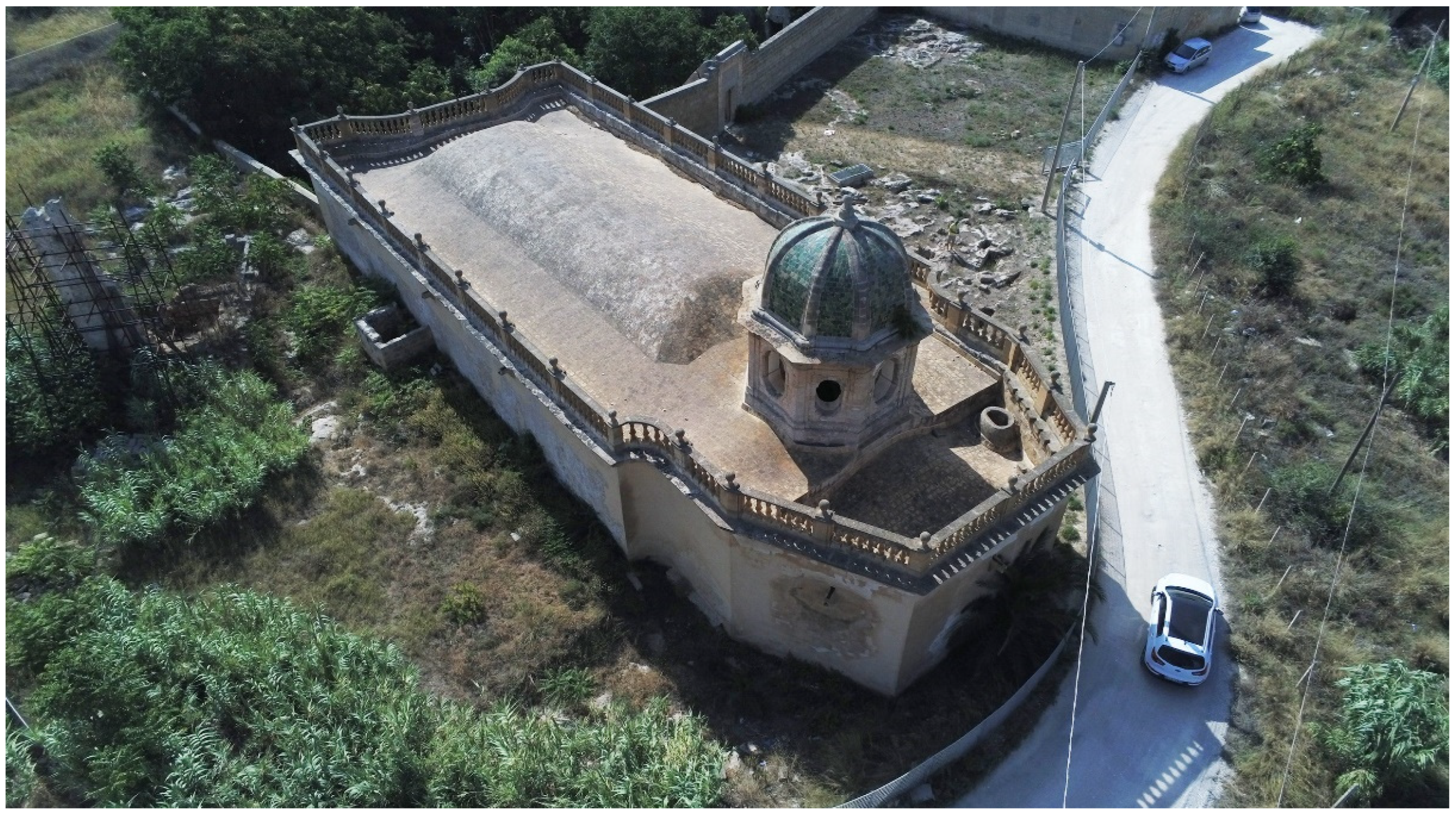
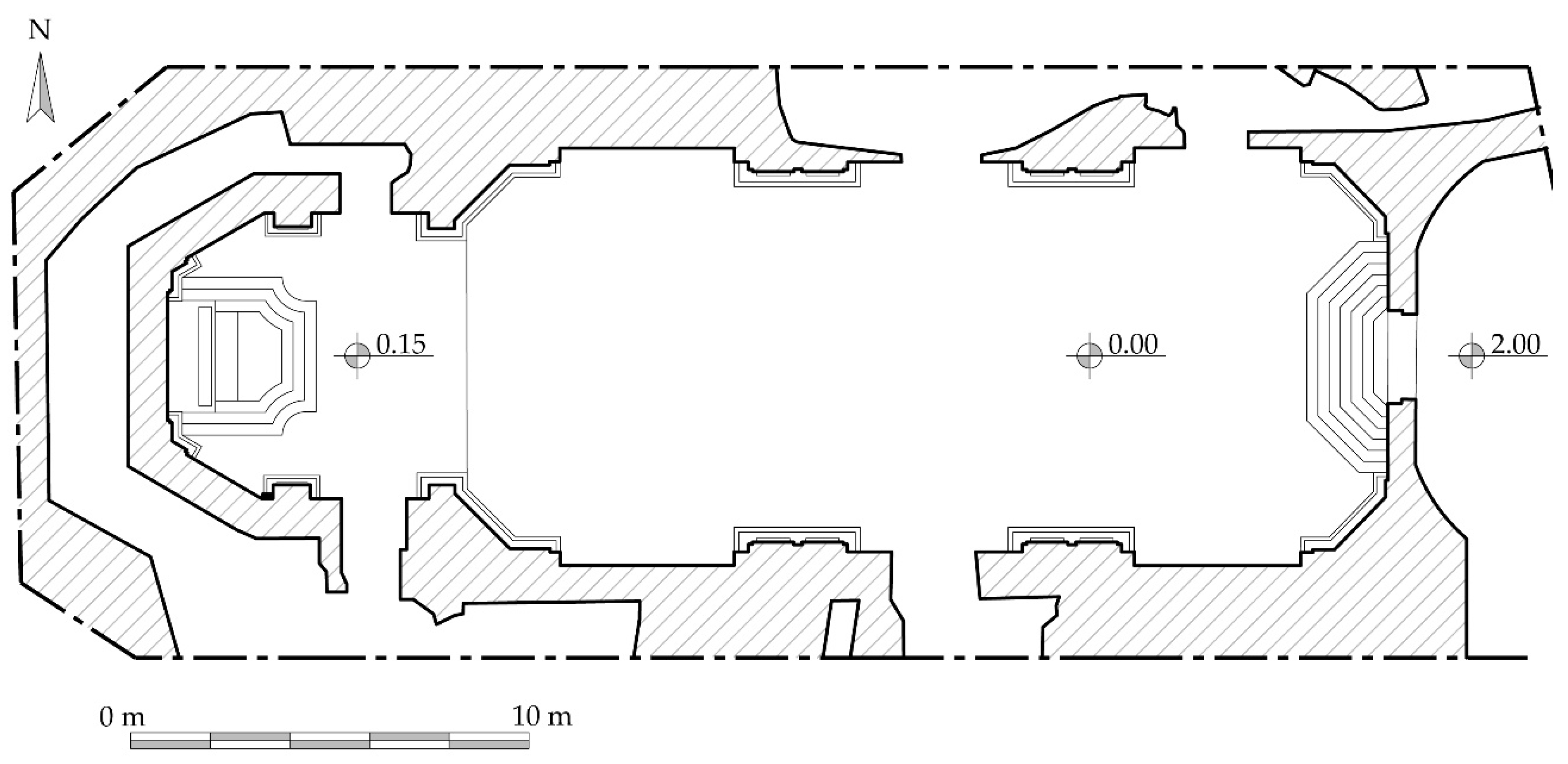
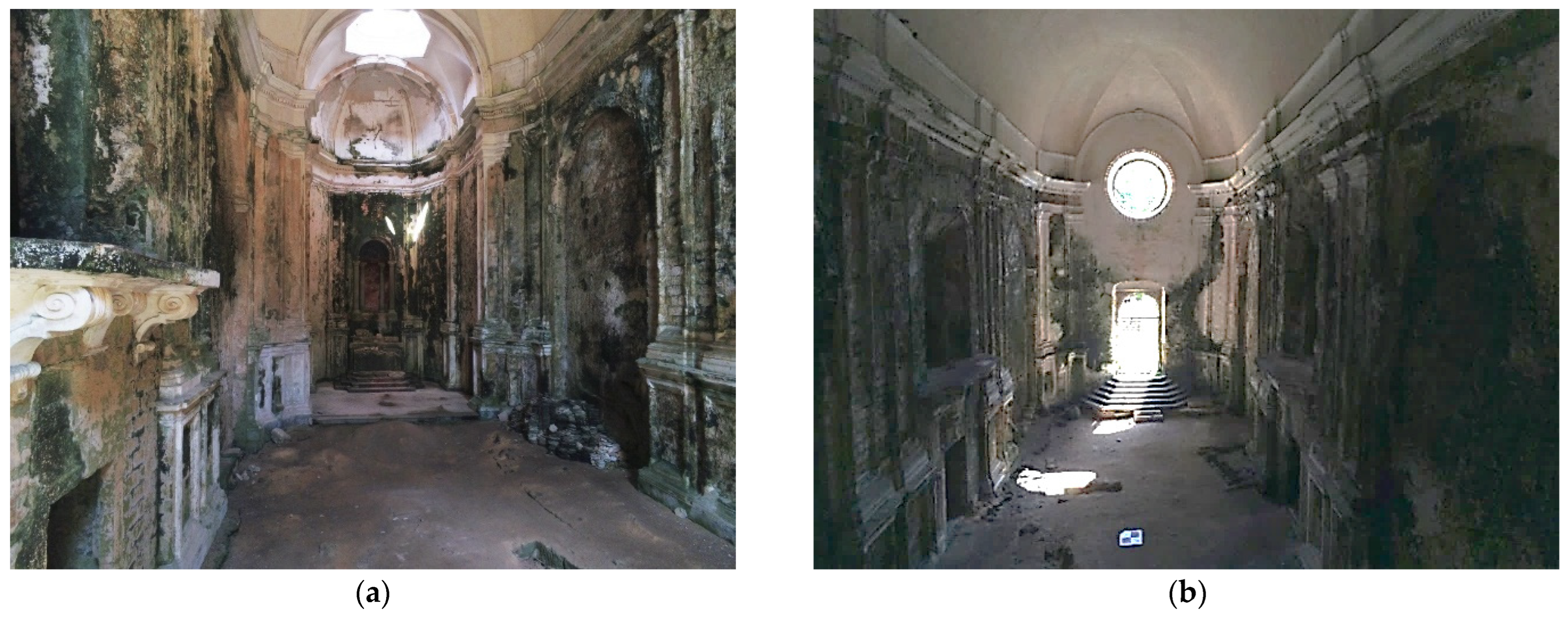
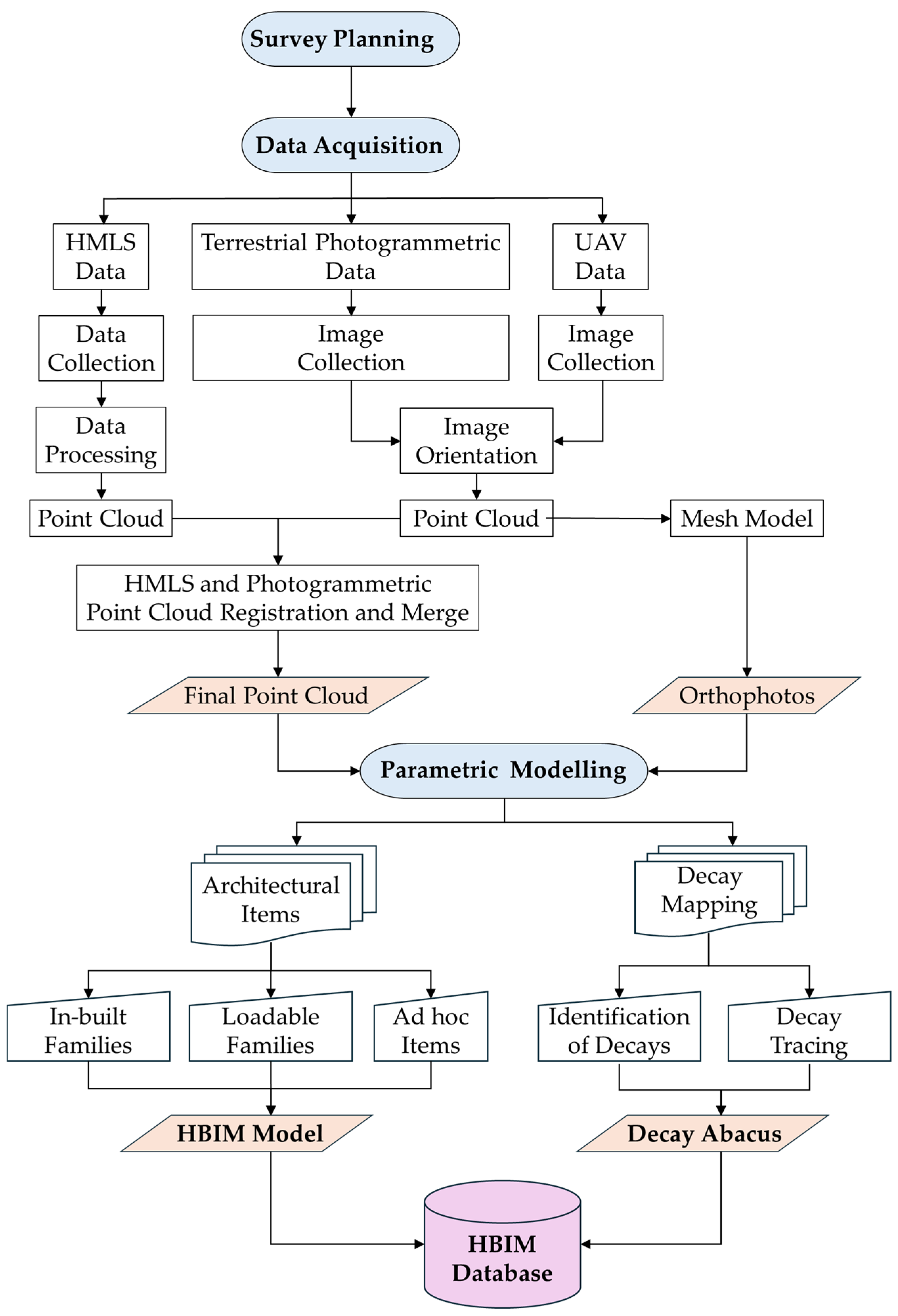
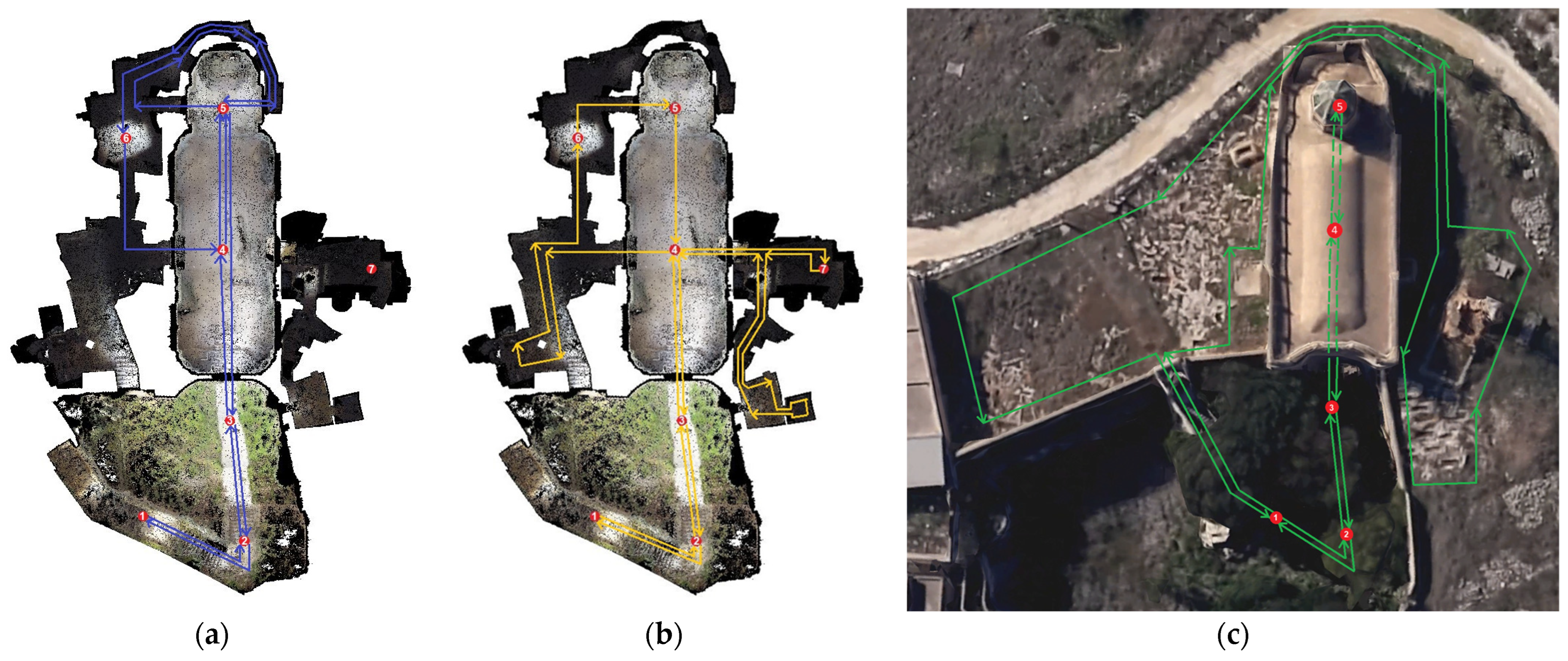
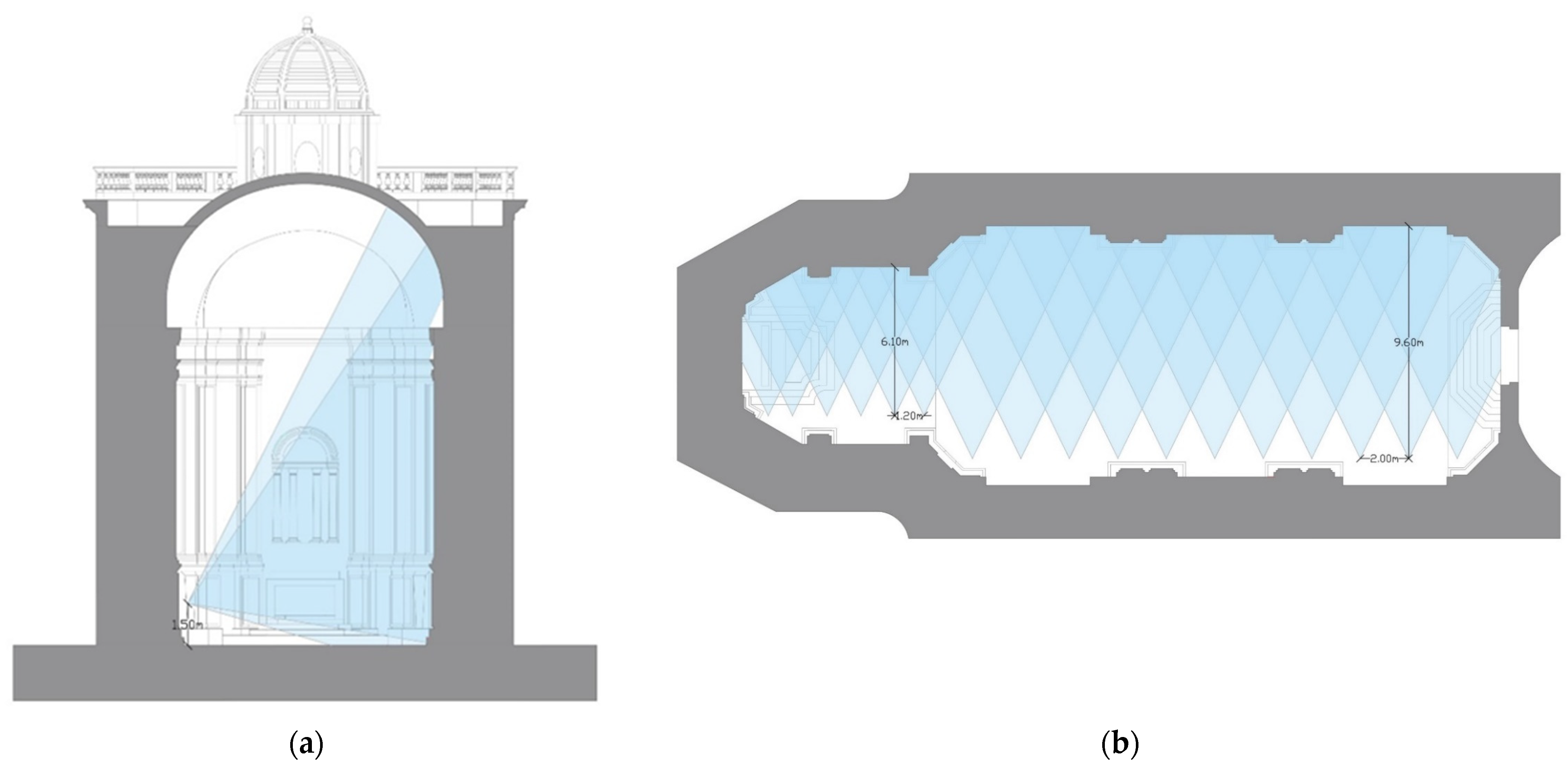


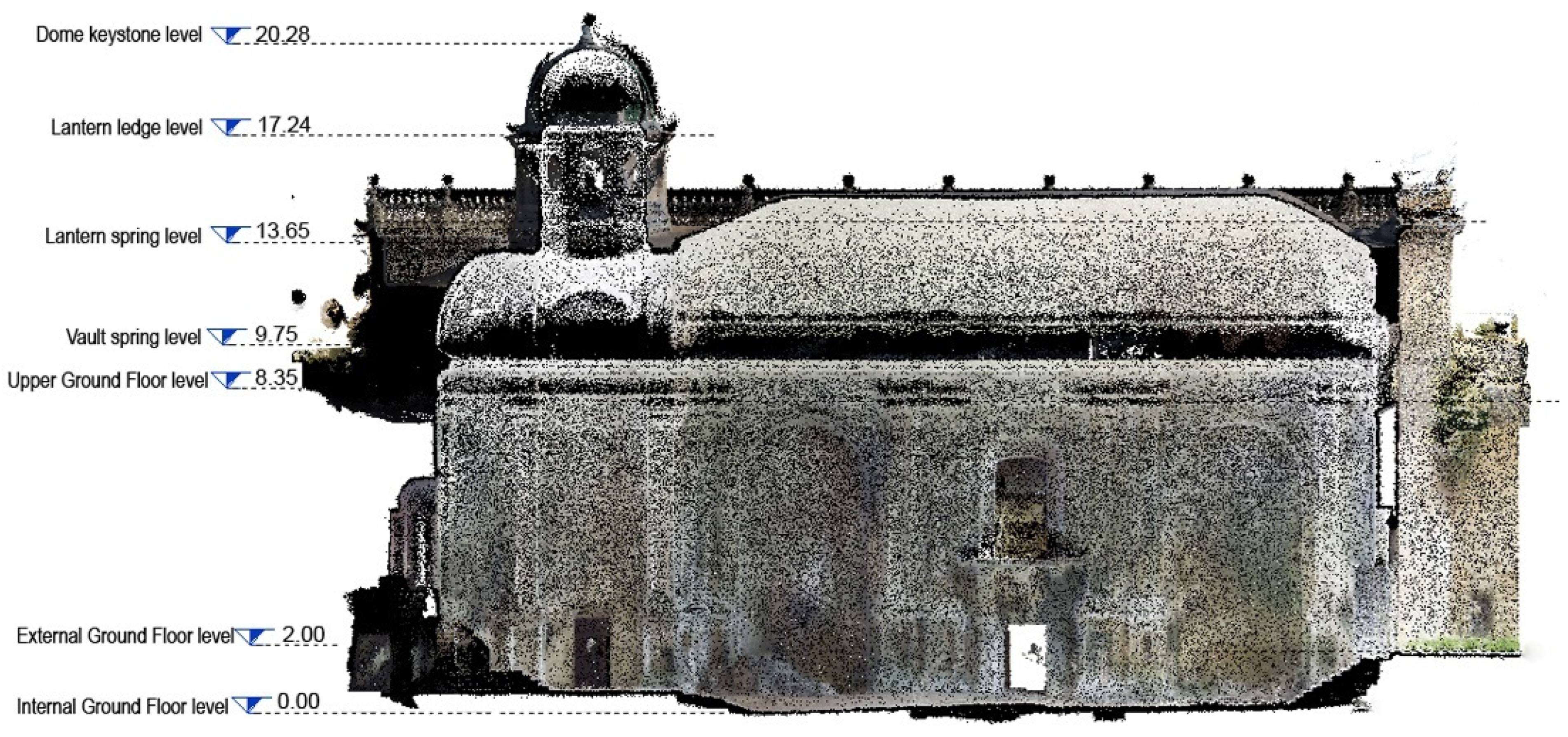



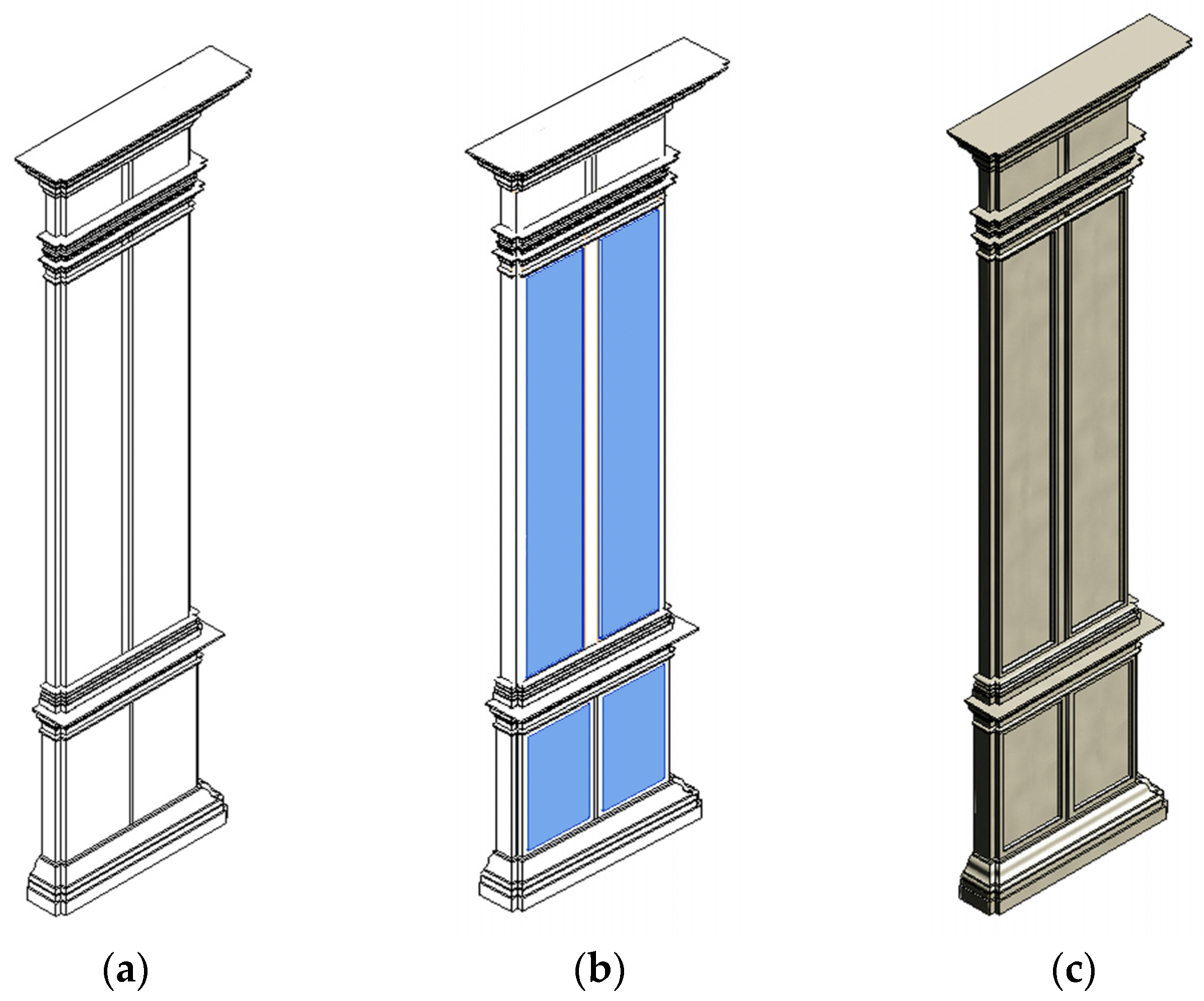

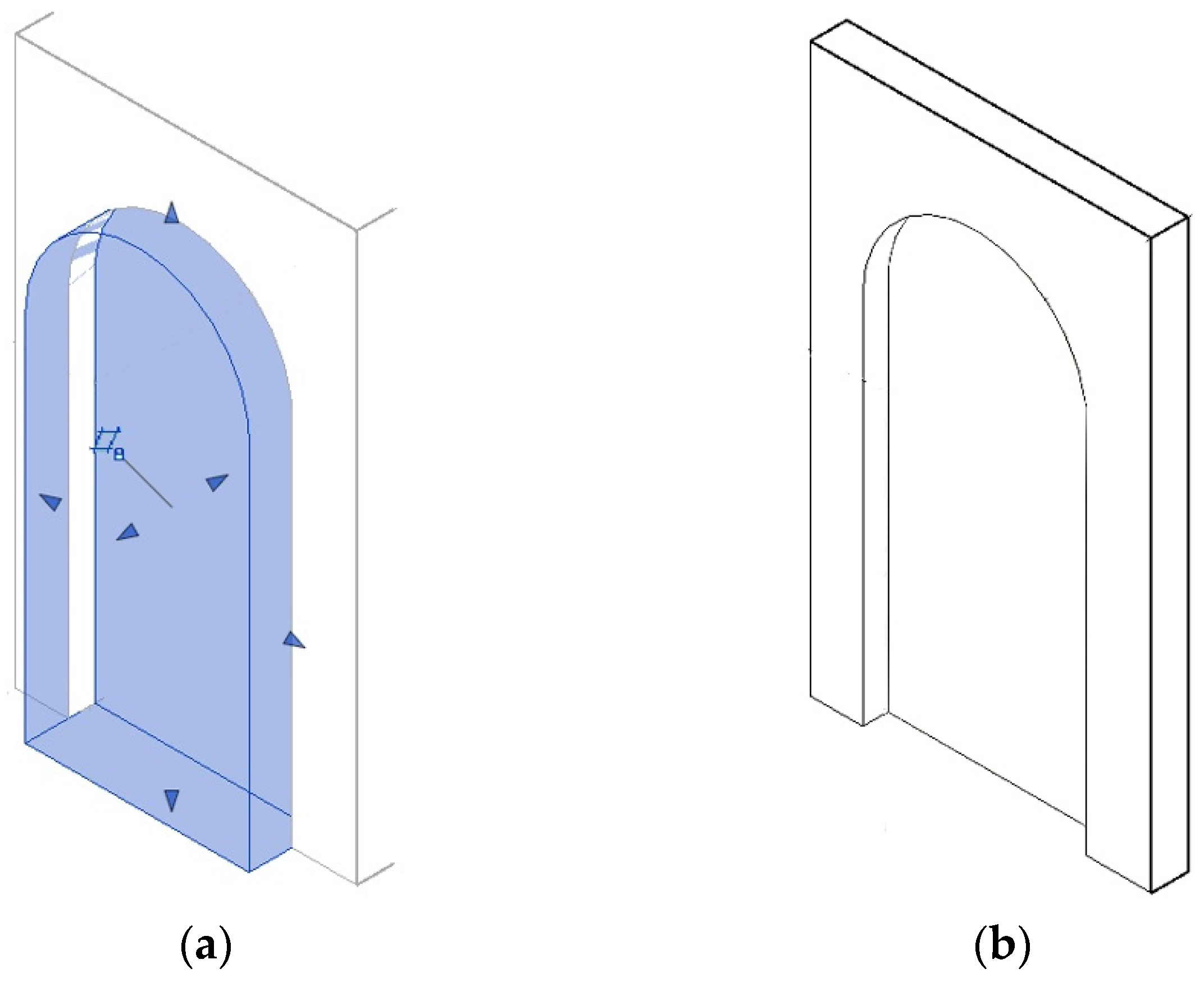
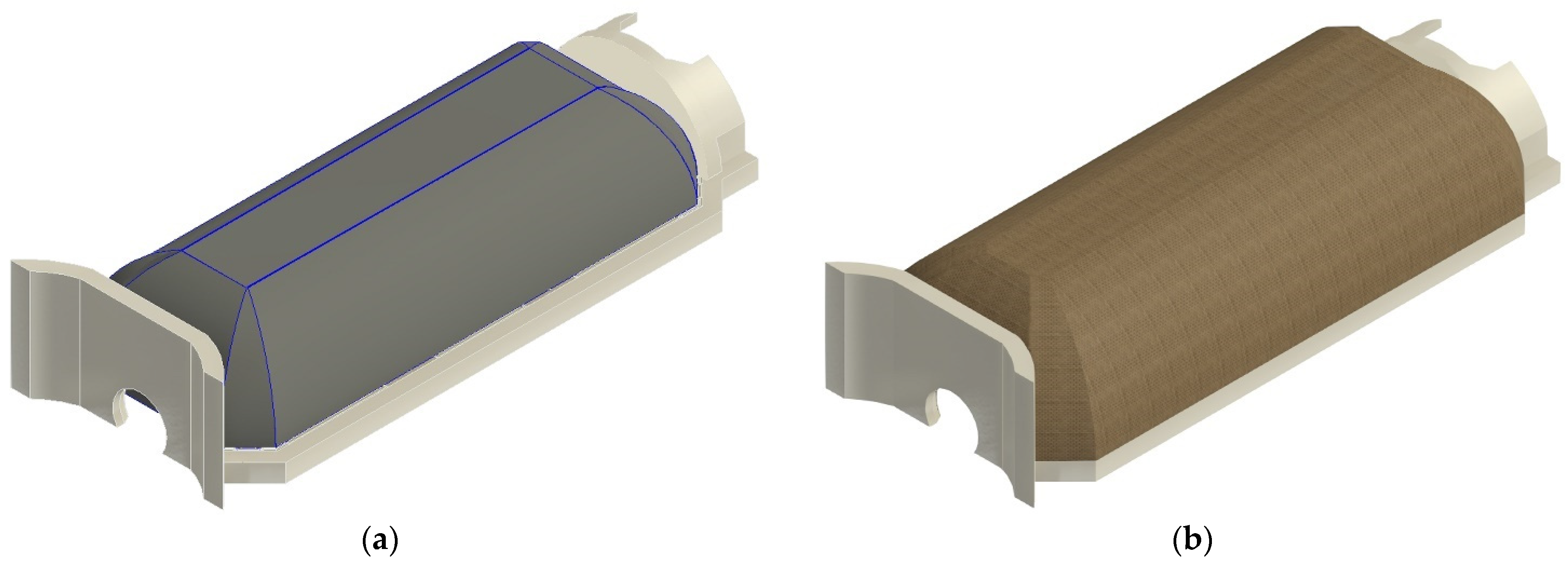
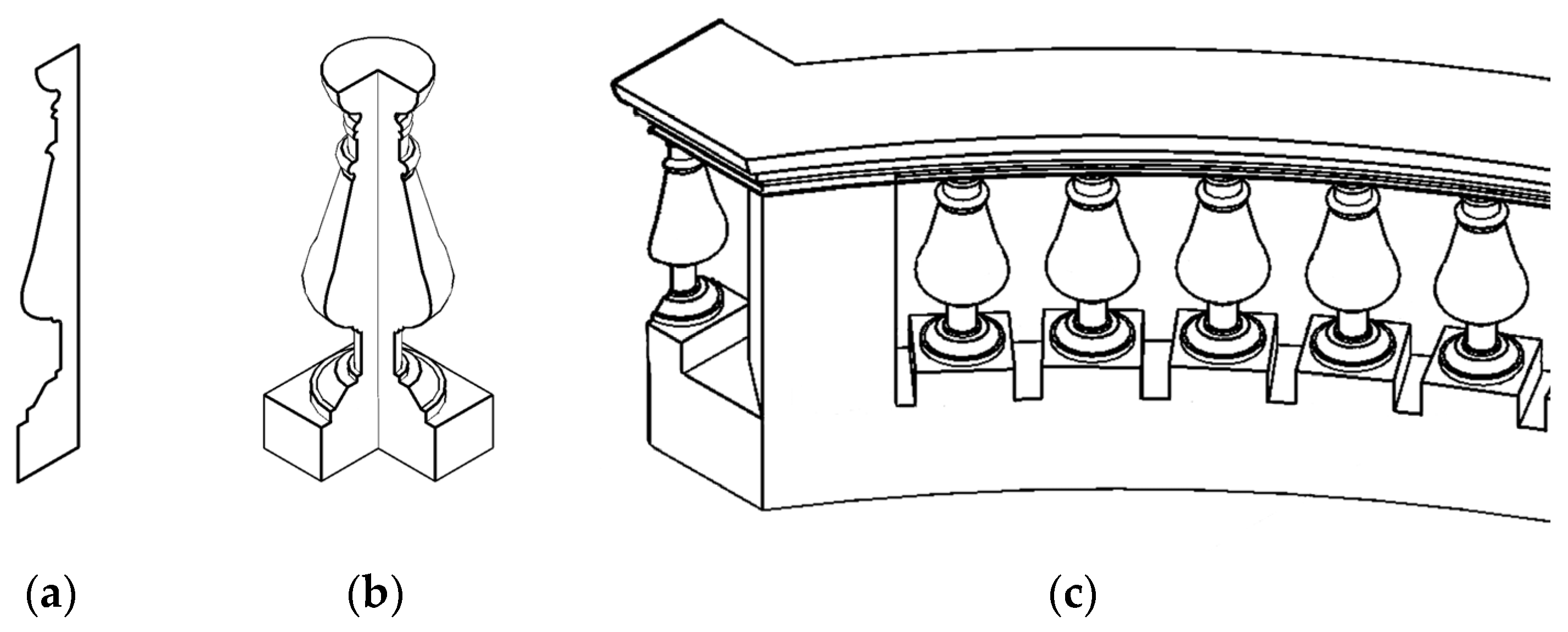

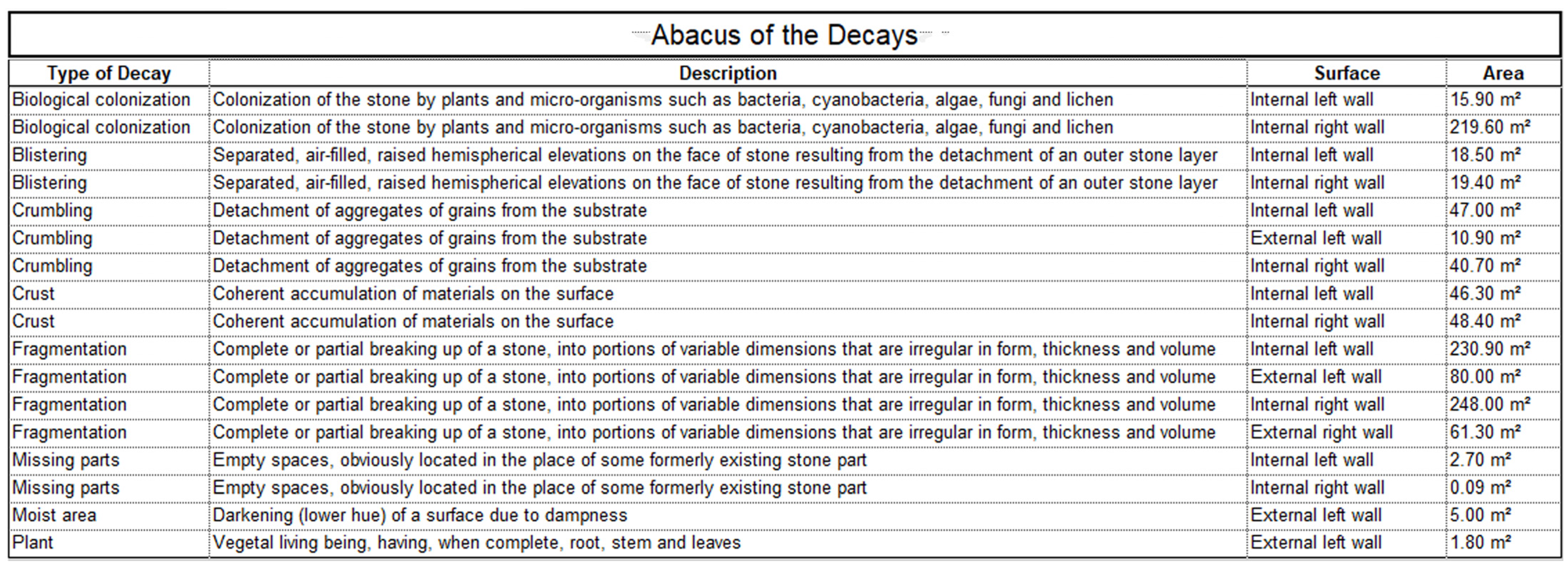

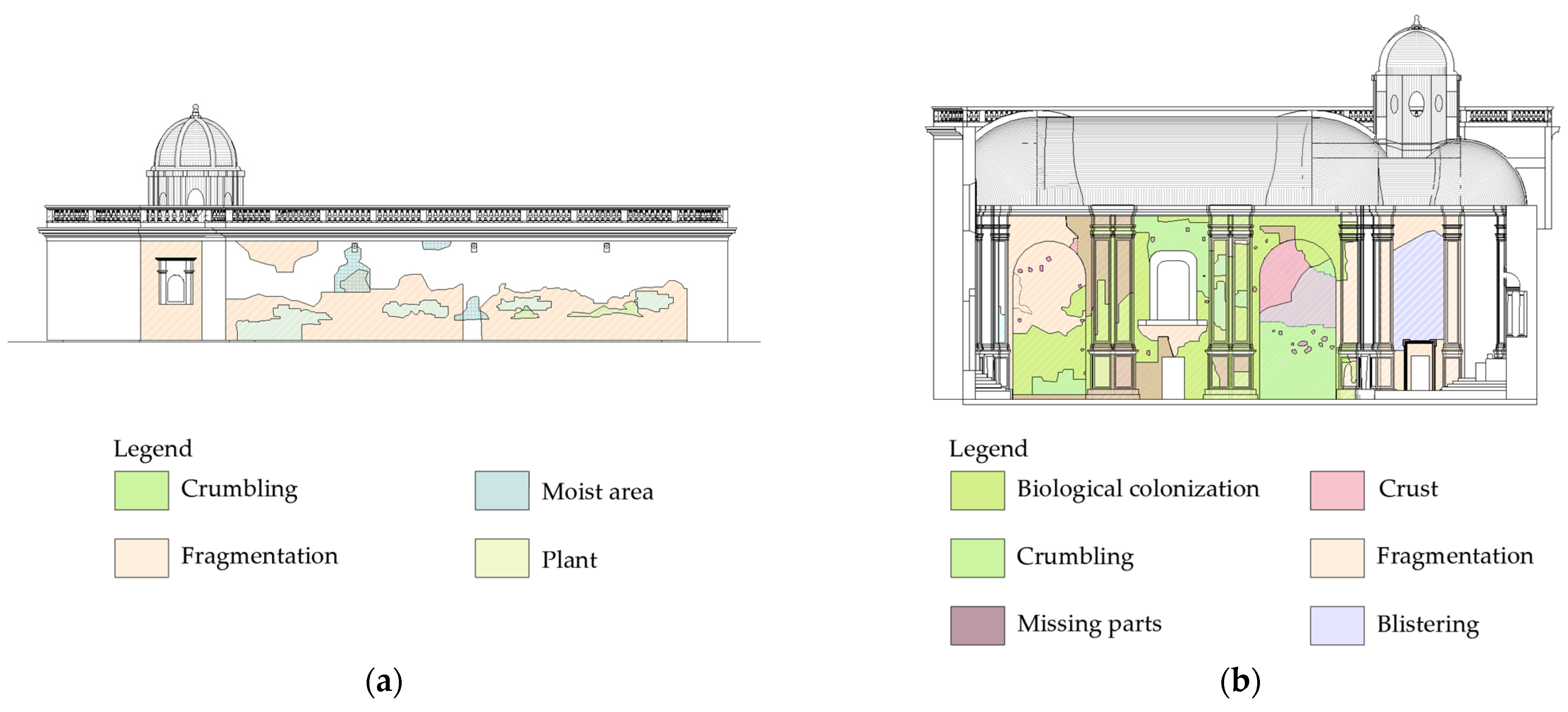

Disclaimer/Publisher’s Note: The statements, opinions and data contained in all publications are solely those of the individual author(s) and contributor(s) and not of MDPI and/or the editor(s). MDPI and/or the editor(s) disclaim responsibility for any injury to people or property resulting from any ideas, methods, instructions or products referred to in the content. |
© 2024 by the authors. Licensee MDPI, Basel, Switzerland. This article is an open access article distributed under the terms and conditions of the Creative Commons Attribution (CC BY) license (https://creativecommons.org/licenses/by/4.0/).
Share and Cite
Aricò, M.; Ferro, C.; La Guardia, M.; Lo Brutto, M.; Taranto, G.; Ventimiglia, G.M. Scan-to-BIM Process and Architectural Conservation: Towards an Effective Tool for the Thematic Mapping of Decay and Alteration Phenomena. Heritage 2024, 7, 6257-6281. https://doi.org/10.3390/heritage7110294
Aricò M, Ferro C, La Guardia M, Lo Brutto M, Taranto G, Ventimiglia GM. Scan-to-BIM Process and Architectural Conservation: Towards an Effective Tool for the Thematic Mapping of Decay and Alteration Phenomena. Heritage. 2024; 7(11):6257-6281. https://doi.org/10.3390/heritage7110294
Chicago/Turabian StyleAricò, Manuela, Claudia Ferro, Marcello La Guardia, Mauro Lo Brutto, Germana Taranto, and Gaspare Massimo Ventimiglia. 2024. "Scan-to-BIM Process and Architectural Conservation: Towards an Effective Tool for the Thematic Mapping of Decay and Alteration Phenomena" Heritage 7, no. 11: 6257-6281. https://doi.org/10.3390/heritage7110294
APA StyleAricò, M., Ferro, C., La Guardia, M., Lo Brutto, M., Taranto, G., & Ventimiglia, G. M. (2024). Scan-to-BIM Process and Architectural Conservation: Towards an Effective Tool for the Thematic Mapping of Decay and Alteration Phenomena. Heritage, 7(11), 6257-6281. https://doi.org/10.3390/heritage7110294







